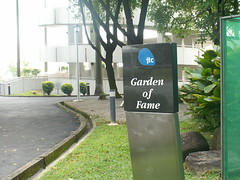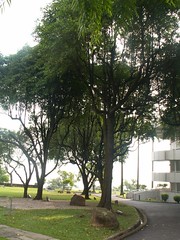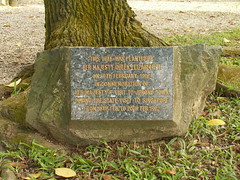 Above photo from National Archives of Spore collection
Above photo from National Archives of Spore collectionAfter the government’s announcement of the Queen’s first visit to Singapore in 1972, the whole island was in a frenzy with the preparation for her visit. The whole of Tanjong Pagar, where our port was located, was to be cleaned up. Since this part of the country was quite unsightly then, an order came down that all the buildings and their surrounding areas needed to be white-washed, spruced up and unsightly parts to be covered up. How? The solution was to rack up wooden panels, like cosmetic cover-up, to hide all ugly sights where the Queen’s motorcade passed through. The seedy bar called 'Toby Paradise', a water-hole for many a tired sailor, was transformed into a dignified place, worthy of VIP’s patronage. In short the whole island was geared to project an unforgettable image to Her Majesty. All government departments were on their toes, nothing was left to chance. There was no such thing as failure in the CS dictionary for this grand occasion. Many top government staff, I believed, had sleepless nights before the big day arrived. Security was at its best and the top bosses were as though placed on war-footing.
The big day came. The whole port was ready for action. Our section, Go-down 46/7, was chosen for the Queen’s yacht, The Britannia to berth. Flowers pots lined all the roads and buildings leading to the berth. As the tugs was pulling the yacht into the berth, our best work supervisor Anthony, dressed in full suit, was commanding his best stevedore, with the best gangway available, to move into position. Anthony looked so smart in his suit that one could have mistaken him for bride-groom that day.
The Britannia crew threw down the ropes which Anthony's stevedores quickly tied onto the capstans. The gangway was efficiently attached to the vessel and here came the Queen with her husband Phillip following behind. The Queen came down to inspect the guards of honour, with band striking out the national anthems of both countries. The whole area was practically red-carpeted. Diplomatic corps were at full strength and PM Lee gave a welcome speech and later acknowledged by her majesty. The Queen impressed upon me as lady of extreme grace and like a swan swimming in a sea of pageantry and pomp.
After the ceremony her majesty and entourage left the port. I as rookie of the port, gasped with awe of the big occasion, that unfolded before my eyes.



Queen Elizabeth II and the Duke of Edinburgh each planted a tembusu tree at the Garden of Fame at Jurong Hill Top. After one quarter century, the two stately trees still stand ‘majestically’ nearest to the entrance to this garden where many dignitaries from all over the world had visited in the early years of Singapore’s independence.






16 comments:
OMG she was here on the day I was born!
Jurong Hill with the sweeping vista of Singapore's industrial region is still one of my favourite places. I still go there regularly for meals at the Hill Top Restaurant :)
And those were the days when most visiting foreign dignataries preferred to come by sea rather than by air, am I right?
Victor - You are right. There was a certain amount of romance linked to past travel by sea. It was an age where people had time to watch the sun rose and set, not the maddening pace set by modern travel. A case in point, during early days when local muslims would congregate in the port waiting for departure to Mecca. Whole community would turn up for the occasion, with cooking done in the hardstand. Everyone was patient for the arrival of the pilgrim ship to take them on at least once in a life-time pilgrimage to the holy land. The sea trip may take a couple of months to accomplish. Nowadays, such travel is being replaced by air, on short notice.
I say this not becos many British friends visit this blog. I think Spore is quite fortunate to have be ruled by the British and not some other colonial powers. Not only they left behind an efficient system of government and civil administration, their young men spilled blood to defend this country in WWII; likewise the Aussies.
Chun Chew, a question for you.
Was Toby Bar somewhere down in Anson Road, next to the old F&N Building?
In 1956, the colonial government of singapore celebrated the coronation of the Queen Elizabeth the second. I remember I was a teen then partaking in the celebrations along North Bridge Road. There was a great multitude of spectators lining both sides of North Bridge Road waiting for the floats and the marching soldiers to pass by. Being short in stature and sandwiched amonst the crowd I had to tip-toe all the time just to catch the spectacle.
British forces were engaged in a life and death struggle in Europe during the height of WWII. As a result, the cream of the arm forces were stationed in Britain. According to my father, Singapore was then defended by the much weaker fighting men from Britain and other commonwealth countries, notably the young inexperienced Aussies soldiers. That was why the much feared 'Tiger of Malaya', General Yamashita, proudly declared that he could subdue Singapore with fewer divisions (than required)from the battle-hardened Imperial Guards. My grandma also related to me that when Singapore was invaded by the Japanese, some young frightened Aussie soldiers were taking refuge in our Kampong and subsequently surrendered to superior Japanese troops.
Peter - You are right, at the end of Anson Road. As for F&N building? maybe nearby but not next. You being a landmark expert, I trust your judgement rather than mine.
Chun See suggests that Singapore was fortunate with its colonial legacy and I would not want to argue against that - there is evident value in the structures and systems that owe a lot to British systems. But even as a teenager I had a slight sense of unease in my position as a 'colonialist', we were never able to make any real connections with the local population (I admire John Harper's family who seem to have had some connections at least), even having an Amah to help with housework in the house was astounding to us who had come from a smokey London suburb..
One thing for sure the combination of that British inheritance and the vigour and energy of Spore's multi-ethnic community have created an extraordinary place!
Amahs and Sam Shui women were very special and tough women. They hailed from Guangchow province in China. They were sworn splinsters very dedicated to their work, with Amahs being domestic helps and Sam Shui women as construction workers. Amahs were very loyal to their employers and treated their employers'children as though their own. On one occasion, I saw a Sam Shui took a wrong bus ended up in a different location. She cursed and swore that she would be late for work. In Singapore these two types of women are greatly respected for their contribution to this country. Very few of the remain and they are quietly fading away due to old age, great women.
Hi! Read about your blog in the New Paper. It is certainly a blog that rocks. Do visit me at http://ganchau.blogspot.com
I come from Penang and hence it is interesting to read some of your accounts about Singapore of olde.
Cheers to more great blogging from you!
Zen
I think the term Amah was much more loosely used by the British in Singapore. Our Amah was quite young and had a boyfried who visited from time to time. I hope we treated her well but you know we were so unused to having any servants I am not sure we knew how to treat them! I remember when my daughter travelled to India before going to University and stayed with some well-off Indian family she and her friend starved rather than ask the servants for food! They were just too embarrassed to rely on servants.
Brian- How to identify a true amah? Very simple, they wore white long-sleeve blouse (cotton) and black silk-like pants, with hair combed into a bun at the back of her head - true professionals. Among her multi-tasked job, they were most talented in looking after children and cooking. Loyalty was their trade-mark. Much tears were shed when their bosses left for home-countries. Apart from Amahs, there were also younger domestic helps, some of them part-timers, working for the British forces, Europeans or even well-to-do Asians. I had a lady relative working as a part-time domestic help for British forces, and when she retired helped her son to set up a western food joint. This showed how good her self-taught cooking was. I believe the young maid your family engaged was from the kampong. Generally their work performance depended on their working experience. If she was a first timer, of course the standard could be average, those experienced ones were real good all rounders, compared to Amahs who were true-blue specialists liken to the medical profession.
Zen
I am sure you are right and I can recall very little about our 'Amah', not even her name (but then I have forgotten even some of my friends names from that time), she may well have been from a local kampong, at that time when our housing estate at Toh Drive was newly built there were nearby kampongs just at the end of the road and I am sure they are no longer there
Zen's description of an Amah fits exactly with my memory of our Amah when we lived in Wittering Road in Changi. Her name was Kim and as Zen said, fiercely loyal to our family. One luchtime she had cooked us egg and chips for lunch and had done them really crisp and a sharp edge lodged in my throat. Kim was absolutely mortified that her cooking had done that to me and always made sure that the chips never had any sharp points on them whenever she did chips. She was a wonderful lady and did all our laundry and cooking five and a half days a week.
Black silk trousers, white blouse and hair tied in a bun with gold rimmed teeth is my abiding memory of this lady who was very much a part of our family.
John Harper
On the subject of loyalty, my relative called Yin (a part-timer)once worked for a Japanese expat.family who has a son. Yin was so closed to the family that the son called her mummy. The family went back to Japan but maintained close contact with her. Whenever the family came back to Singapore they would visit her, taking many photos for memory. Yin had fond memories of her 'adopted son' and proudly showed the photos taken with her 'son' to me.
Post a Comment